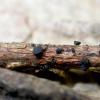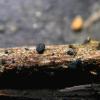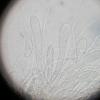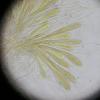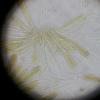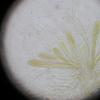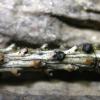
09-11-2025 13:20
Hello.A tiny ascomycete, appearing as erupting gra

08-11-2025 00:29
 Francois Guay
Francois Guay
I found this species in Quebec, Canada, on herbace

04-11-2025 09:07
Hello.A suspected Hymenoscyphus sprouting on a thi

04-11-2025 12:43
 Edvin Johannesen
Edvin Johannesen
Hi! One more found on old Populus tremula log in O

03-11-2025 21:34
 Edvin Johannesen
Edvin Johannesen
These tiny (0.4-0.5 mm diam.), whitish, short-stip
Tympanis (?) on Picea abies
DirkW,
29-03-2021 22:17

Salut a tous,
who can help with this find on young twigs of Picea abies? Most apothecia showed asci with a very diffuse multi-spored (?) content, but some with clearly shaped fusoid spores. So I suppose this is something out of Tympanis or Claussenomyces, where initial spores with significant shape dissolve into diffuse conidia.
It was very difficult to see isolated spores, but I found some few: 16-20 x 4-5, strongly pointed at both poles (like spores of Ascocoryne for ex.) and non-septate (!) up to now. Paraphyses look quite strange (long and winded).
So, spores are too big for Tympanis laricina. All Tympanis on Picea don't seem to fit with these spores. Perhaps I'm completely wrong and overlook a different genus? The Claussenomyces-Species I know have multiseptated initial spores and Conidia clustered in "balls".
All best
Dirk
Quijada Luis,
29-03-2021 23:03
Re : Tympanis (?) on Picea abies
I do not think this is Tympanis. Maybe an inmature Tryblidiopsis
Best wishes
Luis
Best wishes
Luis
DirkW,
29-03-2021 23:22

Re : Tympanis (?) on Picea abies
thats great! micros fit very good!
seems to be an immature Tryblidiopsis pinastri, where the hymenium is not opened yet! i hope it will and I can show it.
thank you, luis!
Gernot Friebes,
30-03-2021 14:04
Re : Tympanis (?) on Picea abies
Hi, Dirk,
best of luck with getting mature ascomata. I find this species frequently on corticated branches of Picea abies and most collections are still closed or only slightly open at best. It seems to mature very slowly. However, it is very nice to look at under the microscope once it is fully mature.
Best wishes,
Gernot
best of luck with getting mature ascomata. I find this species frequently on corticated branches of Picea abies and most collections are still closed or only slightly open at best. It seems to mature very slowly. However, it is very nice to look at under the microscope once it is fully mature.
Best wishes,
Gernot

